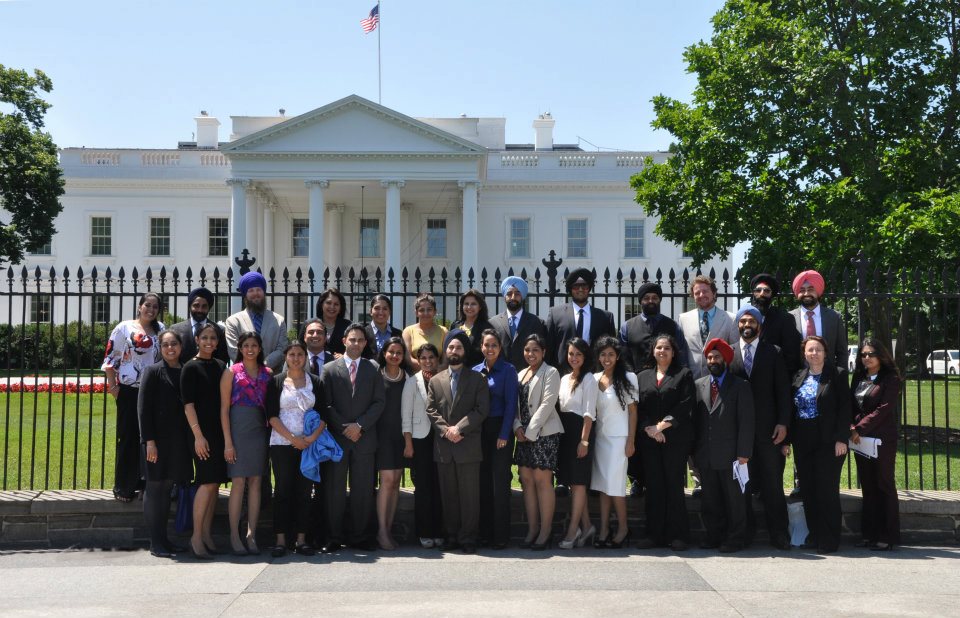
Co-blogged by Sundari and American Turban
Likely unbeknownst to many Sikhs, last Friday marked a historic moment for America’s Sikh community.
Around 7:30am on that day, about 50 people representing Sikh communities from across the country – California, Texas, Indiana, Ohio, Michigan, Georgia, New York, New Jersey – gathered at the East Wing for a special tour of the White House. These members of the community walked through the historic center of the country, seeing with their own eyes notable places such as the room in which President Thomas Jefferson first held cabinet meetings and the Blue Room which remains the reception room of the White House. Following the tour, community members joined White House administrators for the first-ever White House briefing on Sikh civil rights issues.
For those of us in the audience, it was a deeply moving moment – particularly when the briefing started out with Bole So Nihaal, Sat Sri Akal. Yes, a jakara in the White House!
There was something symbolic in that moment. Once, a long time ago, Sikhs would have made the jakara call while raising their flag at the Red Fort in Delhi, the symbolic capital of India, as Jassa Singh Ahluwalia was proclaimed Sultan-e-Quam (‘king of the nation’) – a gesture in which Sikhs laid claim to their sovereignty as a people in 19th century India. Now, under certainly different circumstances in a land separated by time and distance, Sikhs were making a similar call to claim to their legitimacy as Americans.
Caste is one of those dark secrets in our community. Some defend it as “culture”, others downplay its discriminatory effects, and some go even as far as to blame the victims of the violence itself.
Many have documented the ongoing apartheid that exists in our villages and in our minds.

Some scholars have recently looked at the issue in light of the commitment to equality bequeathed by our Gurus, but the continued existence of discriminatory practices by many Sikhs. Professor Natasha Behl sheds some light on this topic in her dissertation, titled “The Politics of Equality: Caste and Gender Paradoxes in the Sikh Community.” She began her research asking the simple questions: How do ordinary Sikhs maintain a belief in equality while also participating in caste- and gender-based discrimination? How do Scheduled Caste Sikhs and Sikh women take political action in a community that engages in discrimination, yet denies its very existence?
Guest blogged by @NSYF (National Sikh Youth Federation)
 The Sikh community in the UK is once again preparing to mark the anniversary of the June 1984 Indian army invasion of their holiest place of worship. Harmandir Sahib, also known as the Golden Temple located in Amritsar, was invaded in an unprecedented Indian army action against the civilian population that resulted in massive casualties and wide spread human rights violations.
The Sikh community in the UK is once again preparing to mark the anniversary of the June 1984 Indian army invasion of their holiest place of worship. Harmandir Sahib, also known as the Golden Temple located in Amritsar, was invaded in an unprecedented Indian army action against the civilian population that resulted in massive casualties and wide spread human rights violations.
Every year for the past 27 years the UK Sikhs have been gathering in Hyde Park London for a protest march that ends with a rally in Trafalgar Square. This year is no exception with the rally taking place on the 10th of June. The rally makes vocal the Sikh demands for justice and has been seen as a show of solidarity and remembrance.
As times have changed and the Sikh diaspora have become more educated and media savvy, their methods of protest have also evolved. Young Sikhs have come together to found a charitable NGO and Think Tank called the National Sikh Youth Federation (NSYF). This organisation, whose motto is ‘To Educate, Inspire and Unite’ has become the platform for an innovative media campaign to highlight the events of June 1984. Utilising both social and physical media NSYF are attempting to create mass awareness. From the 1st to the 10th of June NSYF will be uploading one picture everyday at 0700 GMT via their twitter account @theNSYF centred around the hashtag #10DaysofTerror.
NSYF will be telling the story of June 1984 by recreating the major events of each day with a historic newsfeed, culminating in the release of a video to tie the campaign together.
On the morning September 11, 2001, long time train operator Sat Hari Singh (aka Kevin Harrington) was driving the 4 train towards lower  Manhattan when news of the attacks came in. He quickly directed the train in reverse, leading all his morning commuters to safety. The Metropolitan Transit Authority (MTA) later honored him as a hero of 9/11 for his efforts.
Manhattan when news of the attacks came in. He quickly directed the train in reverse, leading all his morning commuters to safety. The Metropolitan Transit Authority (MTA) later honored him as a hero of 9/11 for his efforts.
Soon thereafter, Singh and other Sikh transit workers as well as hijab-wearing Muslim transit workers were transferred to new jobs hidden from the public eye by the MTA, as long as they chose to wear their articles of faith, which apparently looked a little too “suspicious” in the aftermath of 9/11. After an uproar from the Sikh and Muslim communities as well as countless others concerned with civil rights and religious freedom, they were reinstated to their original jobs but with a caveat: their turbans and hijabs were to don the MTA logo.
“They called me a ‘hero of 9/11.’ I didn’t have a corporate logo on my turban on 9/11,” Sat Hari Singh said. “This policy made no sense. It was driven by fear.”

“But, when you have a beard, a mustache, it’s like a mask. You can’t see the person’s face. It’s hidden.”
As disagreeable as the words sounded, my friend’s tone was very gentle and civil. It was almost as if he was asking me the question: why bother?
I was a nine-year-old Sikh boy with a little mustache fuzz and a patka (a Sikh boy’s headcovering), speaking with the clean-shaven teenaged Hindu boy next door whom I befriended on this extended trip to India. I would often play games with his younger brother, but with this older brother, our interaction usually took the form of conversations about our different cultures and religions.
His point about hair left me somewhat at a loss. I remember his facial expression after he made his statement – curiously waiting for a response that I would not have.
Later that evening, I presented this argument to my father. “He said people can’t see our true faces because of the hair on our face.”
My father didn’t take a second to respond. “This is my face”, he said very matter-of-factly, “this is how a man’s face naturally looks.”
Guest blogged by Naujawani Sardar
 Sikhs in the UK celebrated a victory of sorts today with the news that the national broadcaster, the BBC, ‘regretted’ comments made by a presenter on their digital radio station, the BBC Asian Network. On 13 March, DJ Nihal Arthanayake had suggested on his daily call-in show that Sikhi was “made up from other religions i.e. Islam and Hinduism” [see related article]. When corrected by a listener who texted in to challenge the presenter’s comments, Nihal showed shocking arrogance in asserting that he himself was correct and replied that he knew “more about your religion than you do”. But today’s news is only a victory of sorts with Lord Inderjit Singh of the Network of Sikh Organisations describing it as “not a very good sorry” and in this writer’s humble opinion, a mere bone to keep us from tackling the real problem.
Sikhs in the UK celebrated a victory of sorts today with the news that the national broadcaster, the BBC, ‘regretted’ comments made by a presenter on their digital radio station, the BBC Asian Network. On 13 March, DJ Nihal Arthanayake had suggested on his daily call-in show that Sikhi was “made up from other religions i.e. Islam and Hinduism” [see related article]. When corrected by a listener who texted in to challenge the presenter’s comments, Nihal showed shocking arrogance in asserting that he himself was correct and replied that he knew “more about your religion than you do”. But today’s news is only a victory of sorts with Lord Inderjit Singh of the Network of Sikh Organisations describing it as “not a very good sorry” and in this writer’s humble opinion, a mere bone to keep us from tackling the real problem.
The daily call-in show on the BBC Asian Network has been steadily gaining in notoriety over the last 18 months fuelled largely by an increasing move towards discussions that court controversy. From 1pm-3pm, Monday to Friday, listeners tune in to hear the presenter, callers and occasionally guests debate a topical issue that is usually relating to a section of the South Asian community, followed by a sparse selection of music and further, more light-hearted discussion. Sometimes the initial debates have been incredibly engaging and informative, on other occasions they are needlessly provocative and disparaging.
In recent months, I have been called upon as a contributor to the show a handful of times, speaking live on air as a Sikh voice and I have publicly commended the production team of the show on two separate occasions for talking about challenging issues that are otherwise ignored by mainstream media. Following a discussion show about the recent Immortal Productions release ‘Jaago’ , a show to which I contributed by a pre-arranged telephone call, I took to Twitter to voice how fair I thought the production team had been in allowing Sikhs such as myself to make our voices heard about the rife corruption, inequality and poverty prevalent in the Indian State of Punjab over the last sixty years. Having been in Sikh political circles for over two decades now, I was unsurprised by the immediate level of hate I received from fellow Sikhs for being seen to ‘support’ Nihal and the BBC Asian Network on that occasion, but it did make me realise that Nihal in particular seemed to be drawing much of the ire. Whilst this is to some extent deserved, it would be foolish to reason that replacing the presenter might provide scope to change direction. But this is a difficult reality to impart upon a very unforgiving Sikh diaspora. I made the mistake of trying to explain to a young Sikh female on Facebook that a presenter of a call-in show usually acts in accordance with the briefing given to them by the production team, who in-turn are loosely guided by the direction given to them from the station controller or management, and that if she did have any complaints here they ought best be directed towards the BBC as well as the individual. She proceeded to reply that I must be a blind fan of Nihal’s and was planning on giving him a siropa. Oh the joys of ‘debating’ on social media(!)
By now, you have likely heard of the smartphone app (available for iPhone and Android devices) released by the Sikh Coalition called FlyRights, which was released yesterday (April 30), and is free of cost. The news of this app’s release has spread virally among news outlets and has been applauded by other civil rights organizations and the general public.
FlyRights allows travelers (Sikh or otherwise) to now report complaints to the TSA and Department of Homeland Security (DHS) if they feel that they have been racially profiled by TSA agents.
Based on past experiences, it is an app I wish I had before, but I’m glad that it’s available now.
Tomorrow, May 1st, is International Workers Day and may very well be one of the largest days of mass action and protest we’ve seen in the North 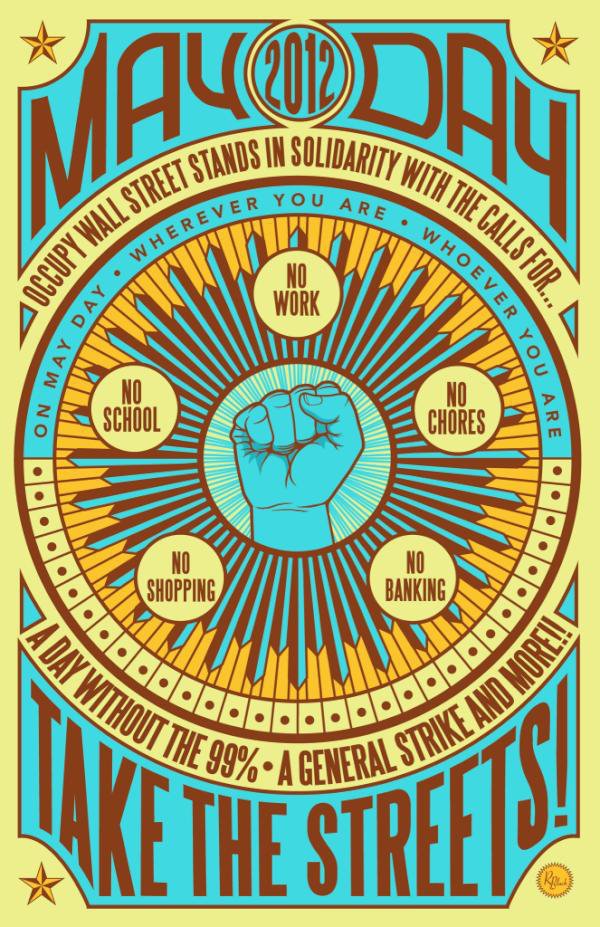 America in some time. Also known as May Day, the day has a long and rich history of working people courageously fighting for dignity and justice.
America in some time. Also known as May Day, the day has a long and rich history of working people courageously fighting for dignity and justice.
May 1st is the original “Labor Day” in the US. On May 1, 1886, 100,000 workers went on strike in Chicago demanding an eight-hour work day. They were met with violent repression from the police who killed four and injured many more. A massive rally against police brutality was organized in the coming days at Haymarket Square where violence escalated. Martial law was declared in Chicago, and police arrested hundreds of activists. The “Chicago Eight” were arrested and convicted solely because of their political beliefs. Seven were sentenced to death, and four were eventually hanged. Hanged for being freedom-fighters. Sound familiar?
In more recent years, May Day has become a mass day of action for immigrant workers rights here in the United States as well. In 2006, literally millions of immigrants and allies took to the streets in the midst of draconian anti-immigrant legislation working its way through the halls of Congress in the first “Day Without Immigrants.”
90 percent of truckers did not show up for work at the Port of Los Angeles, 27 percent of students did not show up for school. In the Central and Imperial Valleys, farm tools lay idle in the biggest agricultural work stoppage in California’s history. Corporations like Perdue, Cargill, and Swift preemptively gave workers the day off in an effort to save face and minimize production losses. In New York, whole neighborhoods closed as Korean and Latino business shuttered their windows. (see: http://maydaynyc.org/history)
Co-blogged by JooKay Singh and Jodha
Our fellow langa(w)r-iter – Navdeep Singh highlighted the dominant pop genre of Punjabi music that celebrates nihilism and suicide through political complicity and destitution. Today, we highlight another form of music that has reached new heights in the shadow of the Shaheed.
UK-based producer Tru-Skool’s latest dharmic-track, ‘Beant Satwant Da Badla‘, which will be part of the 10th Shaheedi Immortality album, has topped the BBC Official Asian Download Chart this weekend gone. This isn’t the first time one of the Shaheedi Immorality tracks has been on the BBC Asian Network playlist (Tigerstyle’s Son of a Sardar and Jhooldey Kesri Chande have previously been played by Bobby Friction, Nihal & Adil Ray amongst others), and some would argue this track isn’t pushing the envelope musically or lyrically, since the Immortal Production (IP) collective have been putting out similar tracks for the past 10 years. So, what’s different, and is this a flash-in-the-pan riding on the back of kesri lehar, or is there more?

Previous IP tracks were given play time on the BBC courtesy of their association with Tigerstyle, who are well respected in the UK as innovative producers, rather than for the tracks themselves; diligent listeners will have noted that the songs were also edited to remove ‘controversial’ lyrics. In Jhooldey Kesri Chandey, for example, the first thirty seconds or so contained part of a speech by Baba Jarnail Singh Bhindrawale, and was removed entirely. Beant Satwant Da Badla, by contrast, has received air time by virtue of being the most officially download ‘asian’ track last week in the UK and was played unedited.
The last few weeks, Sikhs around the world have been celebrating the anniversary of the birth of the Khalsa. I intended to do a Vaisakhi post earlier, but travels have kept me from sitting down and writing down some of my reflections until now. I have found myself in small and medium-sized towns throughout the midwestern and southern United States these last two weeks, feeling my outward identity as a Sikh projecting more conspicuously than ever.
NYC's Annual Sikh Day Parade
Consequently, I began thinking a lot about the significance of the Bana that Guru Gobind Singh gave us in 1699. What a fearless, defiant act of revolutionary love it was for Sikhs to wear their identity so visibly in a time when they faced such severe violent repression. A time when it was dangerous to be a Sikh, where being a Sikh meant you were an enemy of the empire, a threat, where there was a price on your head, a target on your back. Yet rather than blending into Indian society and building its movement for sovereignty and justice subversively, the Khalsa wore its identity loudly and proudly so everyone knew very clearly who a Sikh was.
I think about this today as more and more of cut our hair because we can’t take the torment of bullying in schools any more or trim our beards so we look more “professional” at our corporate jobs. Bana seems to have lost its appeal to many, for an ever-expanding list of reasons. Looking back at our history, it never has been easy. And perhaps that is part of the point. I wouldn’t wish the traumatic experience of racist harassment on anyone, but I know very well that I wouldn’t be the person I am today without all the struggles I have dealt with because of my Sikh identity.
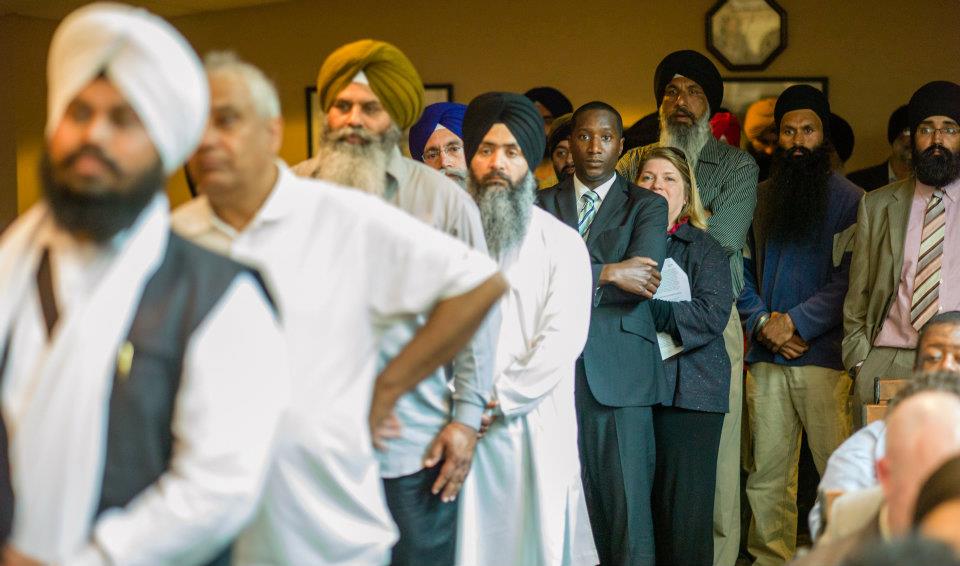
Credit: Karaminder Ghuman, Courtesy: The Sikh Coalition
The Sikh community is leading the way to strengthen law that will protect Sikhs and other religious minorities from job discrimination in the workplace. AB1964 – or the Workplace Religious Freedom Act (WRFA) – has been introduced by Assemblymember Mariko Yamada and is co-sponsored by The Sikh Coalition. Earlier this week, in a show of community leadership, the California Sikh sangat packed a hearing room in the California Assembly and testified in favor of AB1964. As a result, the bill passed through the Labor and Employment Committee and will be considered by the Judiciary Committee on Tuesday April 24th. The Sikh Coalition states that,
This is the first time in California’s history that the Workplace Religious Freedom Act has survived a committee vote, and this is a credit to the power of Sikhs to provide leadership on civil rights issues for all Americans. [link]
Why should Sikhs care about WRFA?
Sikhs suffer high levels of employment discrimination because of their Sikh identity. Many are told to shave their beards; others are told to remove their turbans; some are told that they can only work out of public view. If enacted, WRFA would make it harder in each of these cases for California employers to discriminate against Sikhs.
Guest blogged by Sharandeep Singh
Sidak, run by Sikh Research Institiute, is a diamond among jewels. It is one program, which after attending, completely changes your outlook on Sikhi, and life – I speak unequivocally when I say there is nothing else like it!
As a graduate of Sidak 2011, I want to share my experience to motivate and inspire whoever reads this to attend, so that you too can join the ranks of people who have enriched and developed their understanding of Sikh culture and history.
The annual retreat, based in Texas may seem daunting, particularly for me—it being my first trip to the US—I arrived with a feeling of trepidation, not fully aware what awaited me in the two weeks ahead. Suffice to say, I was not disappointed.
 Following the success of the third Sikholars conference in February, the Jakara Movement is allying with the Canadian Sikh Coalition to bring the conference to British Columbia.
Following the success of the third Sikholars conference in February, the Jakara Movement is allying with the Canadian Sikh Coalition to bring the conference to British Columbia.
This unique forum brings together researchers, budding scholars, and community members in conversations about some of the most pressing issues. For this year’s inaugural conference, a theme has been selected: Theeja Ghallughara: On Justice, Memory, and Transmission. The conference will be held at Simon Frasier University from June 16-17, 2012. Please help circulate and encourage young scholars to send their abstracts before May 16, 2012 for consideration.
The scope of the conference is global; papers may concentrate on particular localities or regions, or they may present cross-regional comparisons and convergences. We encourage submissions from a broad range of disciplines, methodologies, and perspectives. All approaches will be considered – from medicine, to law, to history, sociology, media studies, etc. so long as they are related to the theme.
You can get more information about the conference at the Sikholars website.
UPDATED: All of a sudden I remembered a video from KPS Gill. Readers on this site are aware of this murderous sadist, but maybe it is still worthwhile to juxtapose his lies with the findings announced this week.
All of our attention shifted towards Punjab last week. There was some interesting developments early this week. One is that Voices for Freedom, a non-government organization, based out of Punjab filed a public interest litigation (PIL) petition against the Sukhbir Badal’s appointee for Director General of Police (DGP) Sumedh Saini. Saini is a well-known human rights abusers and was involved in the many murders, “disappearances”, and torture during the 1980s and 1990s. From the media reports, while the petition may not go far, hopefully it does center some more attention on just the type of thugs that the the Badal Mafia appoints.
Another note from Punjab came yesterday when the National Human Rights Commission (NHRC) of India announced that they would pay Rs. 175,000 (about $3,500) to 1,500 families in the Amritsar district for the murder of their sons. Of course there is no culpability, just an attempt to buy silence. Well-known human rights lawyer Navkiran Singh of Chandigarh has rightly state:
It is too little too late and why only from Amritsar District? Khalra gave example of Amritsar district, but wanted an inquiry for the whole of Punjab. Imagine we had to pursue the matter in the NHRC for 17 years for this little justice.
UPDATE: I just wanted again to stress the lies that KPS Gill has restated for years. See this interview with an Australian journalist, when asked point-blank about the case of illegal cremations, KPS Gill lies without hesitation. Contrast this where the NHRC admits it occurred and even pays out money to families, though without casting any blame or responsibility. I have yet to see a true Indian journalist expose KPS Gill for his lies. Unfortunately they continue to lionize him, assuring that impunity continues – whether in Punjab, Delhi, Gujarat, Kashmir, and many other regions of South Asia.

 The following is a guest-post, In Defence of Assassination: Balwant Singh Rajoana’s Gift to the Nation, by our guest-blogger Inklabi Singh.
The following is a guest-post, In Defence of Assassination: Balwant Singh Rajoana’s Gift to the Nation, by our guest-blogger Inklabi Singh.
Balwant Singh Rajoana has been in jail since 1995 and was sentenced to death 5 years ago, but it was only recently, as the date of his execution started to loom closer, that a wave of indignation and concern swept over the Khalsa Panth, both in Punjab and the Diaspora. As others have written, this is a spontaneous response to the power of a Sikh fully in love with his Guru and Panth, completely at ease with the will of God and unequivocally unafraid of death. This popular movement leaves many of us in a predicament though. The dilemma we face is that we are socialized to view acts of violence as inherently immoral. How then are we able to express love for an individual who planned and helped carry out the suicide bombing of an unarmed old man? Balwant Singh’s case puts us in an uncomfortable position. Can we defend assassination? Can the killing of unarmed officials be justified? Are such acts true to Guru Nanak’s vision of compassion and respect for diversity?
Many have been asking why the Indian government attacked Sikhs in 1984 in the first place. How did we reach a point that Balwant Singh felt he had no choice but to assist in the killing of Chief Minister Beant Singh in August of 1995? We can go through the history of South Asia and clearly delineate the path from the Independence struggle, through Punjabi Suba and Emergency to the Amritsar Massacre of 1978, but the short answer is a simple one. It is the same reason the British tied Sikhs to cannons in 1885, the Mughals executed 200 Sikhs a day for weeks in the courtyard of the Red Fort in Delhi in 1716 and why Guru Arjan was burned alive for five days in Lahore four hundred years ago. It is because we did what Guru Nanak compelled us to do, to speak truth to power and not be silent in the face of tyranny just as he did when he condemned Babur the Mughal’s invasion of India. That act, enshrined in Guru Granth Sahib jee, of standing with the oppressed against the oppressor, has led to generations of Sikhs putting the principles of freedom and human rights above their own safety and wellbeing.
This is never a fair fight. The oppressor controls vast resources and commands huge armies that dwarf our meagre numbers. This was true when Guru Gobind Singh’s forty Sikhs held off the entire Northern army of the Mughal Empire at Chamkaur for a long cold and wet night in December of 1705 and it was true when Baba Jarnail Singh and his band of a few hundred young men and women stood like a mountain against the technological might of the Indian army for a long, sweltering week in June of 1984. We will always be the minority for we take the uncomfortable, unpopular and dangerous position; we forsake the riches of collusion and collaboration for the principle of equality and justice, even if it means a tortured death.
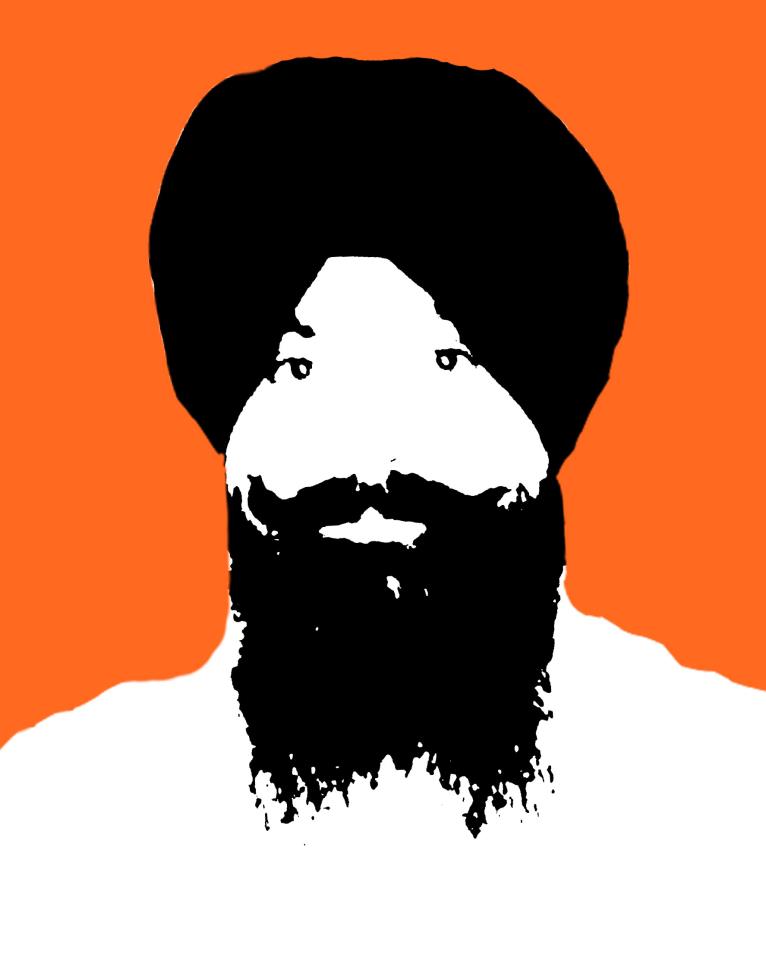 News has started to trickle on this day that Bhai Balwant Singh Rajoana was initially scheduled to be hung. Due to the stay ordered by President Patil of India, there is an indefinite delay.
News has started to trickle on this day that Bhai Balwant Singh Rajoana was initially scheduled to be hung. Due to the stay ordered by President Patil of India, there is an indefinite delay.
On Gurdaspur
News media are reporting the Punjab Police has suspended SSP (Senior Superintendent of Police) of Gurdaspur, Varinder Singh, for the shooting and has registered a case against the DSP (Deputy Superintendent of Police). This has only occurred due to the pressure of the sangat, especially that of Jaspal Singh’s family, who have refused to perform the cremation until the arrest of the Shiv Sainiks and police officials. According to some reports via Facebook (so read with caution) heads of the Sant Samaj coalition along with Jathedar Gurbachan Singh had started a dharna along with Jaspal Singh’s family calling for the police officers that ordered the firing to be punished. Badal was against this action by Gurbachan Singh, but Gurbachan Singh and heads of the Sant Samaj threatened to call for a bandh in Gurdaspur, if action was not taken. Badal then conceded to the request and brought about the orders against some police officers, though I have not heard anything about charges or FIRs against the Shiv Sainiks. If this is true, expect Prakash Badal to REIGN in his appointee – Gurbachan Singh – and for him to better play the role of a puppet. Gurbachan Singh knows who pulls his strings and this act of independence will be punished. Expect more pro-Badal quotes and a calling for an end to all events. We would do well to begin ignoring him.
Other news in Punjab
Members of the Sikh Channel were detained by Punjab Police for four hours. This is a serious blow against freedom of the press. While we are excited that they have been released, we hope that UK Sikhs put full pressure on the UK Foreign Office to reprimand the Indian Government on such matters. When UK journalists were captured in Iraq, Libya, and other war-zones, the Foreign Office helped put pressure for their release. We would expect them to lodge a complaint against Indian officials in this matter as well. If someone from the UK is drafting a letter and would like to share, please send us the link.
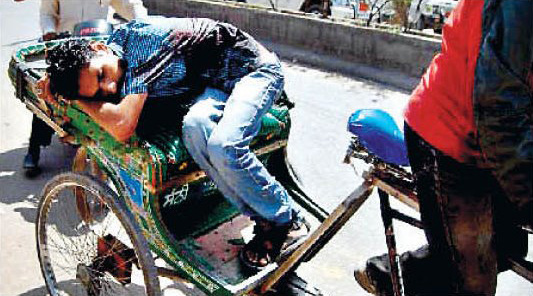
It has now been confirmed by Navkiran Singh, well-known human rights advocate and a lawyer for Bhai Balwant Singh Rajoana, that Ranjeet Singh is in critical condition, but is alive. Our apologies for the incorrect information, but one can understand that with information from Punjab being limited, details are being lost.
Yesterday I wrote about Jaspal Singh, whose loss became well-circulated, due to social media and the outstanding work of Sangat TV and the Sikh Channel.
A very young Ranjeet Singh Mandher, only 16 years old, son of Jaswinder Singh, from village Pandher (Mukerian road) was shot by police. With the heavy police fire, no one came to help him. The veer had to take his own rickshaw to the hospital. From there the hospital in Gurdaspur sent him to Amritsar, where he is in stable condition. I am including the only picture I have received of the youth. If others can provide more information about this young student, please do send it to us.
In other news, Bibi Kamaljeet Kaur was not allowed to meet the family of Jaspal Singh in Gurdaspur. She was stopped on orders from the government. Such is the government of Badal, where police offers open fire and underlings can only be suspended. It only follows the logic of one that would promote a murderer as Sumedh Saini as DGP and give coveted MLA seats to the wife of a butcher like Izhar Alam. The Punjab Government fears Bibi Kamaldeep Kaur and are trying to limit her movement. At present, she is still giving interviews on Sangat TV and other media outlets. Sangat TV has a livestream that can be seen here as does the Sikh Channel, which can be seen here.
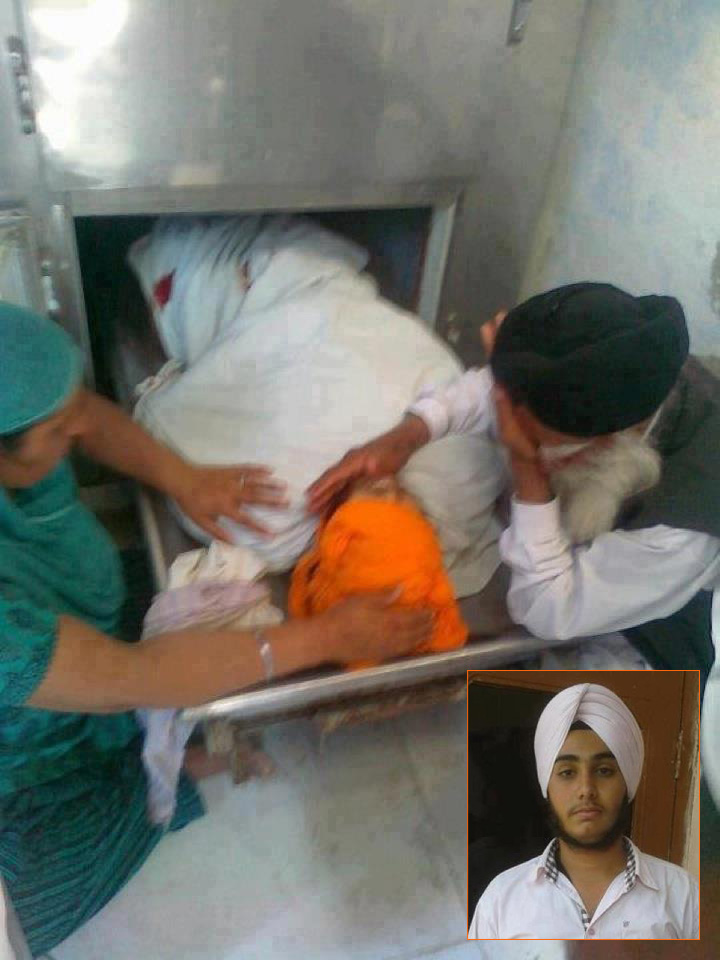 Details are murky, so to do a full analysis at this point is difficult. Right now, we stand to document the events. According to numerous reports, Shiv Sena from mainly Gujarat and Maharastra are entering Punjab. Gurdaspur has been a long-time stronghold of the Shiv Sena as well. Those that are arriving seem to be arguing that if Sikhs could shut down the state yesterday that they would be able to do it today. Read here from our live-blogger from Amritsar that shares much of the same information.
Details are murky, so to do a full analysis at this point is difficult. Right now, we stand to document the events. According to numerous reports, Shiv Sena from mainly Gujarat and Maharastra are entering Punjab. Gurdaspur has been a long-time stronghold of the Shiv Sena as well. Those that are arriving seem to be arguing that if Sikhs could shut down the state yesterday that they would be able to do it today. Read here from our live-blogger from Amritsar that shares much of the same information.
At Gurdaspur this morning, Jaspal Singh, a young 18 year old Sikh boy from Chor Sidhvan village, was killed by police firing. Below the tab you can find an eye-witness video of how the Sumedh Saini’s rogue police has differential treatment towards the Sikh youth and the out-of-state-arriving Shiv Sena. Remember it was Sukhbir Badal, the so-called heir apparent, that personally chose this known human rights abuser to be the Director General of Police. Murders are lauded in Punjab. It was this same Badal that ran for election the wife of the one of the worst butchers of Punjab – Farzana Alam. Farzana’s husband, Izhar Alam, ran his own crack team, called the “Alam Sena” that would give criminals unlimited powers to run wild. His own atrocities are stunning. Eye witness accounts describe his atrocities on women and his summary executions. These are our new “leaders” of Punjab installed by Badal

 Day 2, March 29: Day after 1st Punjab Bandh
Day 2, March 29: Day after 1st Punjab Bandh
I tend to spend my nights at the Darbar Sahib, emerging from the complex around 9 am from the Manji Sahib jorha house. What I saw this morning near the South side of the Darbar Sahib complex near Baba Atal was notedly different from the scenes described yesterday.
As I walked towards the South side of the complex, there were sounds of people yelling and a general sense of urgency in people around me. When I reached the street, there was a large haphazard group of people filling the street speaking loudly and excitedly to each other. Many were kirpans and some had sticks in their hands.
I headed to the side to make my routine stop at the Nescafe shop for some coffee and learned from the Nescafe Uncle that Shiv Sena was coming to Punjab cities to exact retaliation for the arrest of 14 Hindu men/boys in Ludhiana yesterday. The 14 men/boys had been arrested as they caused damage/ruckus in front of Sikh shops that had been closed on Punjab Bandh, and got into a tussle with local groups of protesters as well. Shiv Sena had declared that if Khalistanis could shut down Punjab on Wednesday, they would shut it down on Thursday.
I headed next door to the Bram Butta Bazaar to run some errands, where the Uncle Ji at the shop excitedly explained that a group of Shiv Sena had entered the city at the Hall Gate (Amritsar Khaas) and started throwing stones/bricks at open businesses. I had noticed earlier that some of the shops were still closed today even though Punjab Bandh was yesterday. From the shop Uncle I learned that Shiv Sena called for Hindus to close their shops today. Shiv Sena was now harassing businesses that were still open, businesses that were expected to be of Sikhs or of non-sympathizers. Many of the Bram Butta Bazaar shops also started to bring in their displays and the Uncle urged me to run my errands tomorrow and get out towards the West side of the Darbar Sahib complex and head home.
 The following are daily live reports we have been receiving from a friend in Amritsar. This came from yesterday (March 28, 2012) on the Day of the Bandh. So long as we hear from them, we’ll keep posting. We’re posting this exactly as they wrote it – spelling, capitalizations, and all.
The following are daily live reports we have been receiving from a friend in Amritsar. This came from yesterday (March 28, 2012) on the Day of the Bandh. So long as we hear from them, we’ll keep posting. We’re posting this exactly as they wrote it – spelling, capitalizations, and all.
Hi guys, a friend asked and I know a few others might be curious so here is what i’m seeing today. Sorry for being somewhat terse and possibly rambling, I’m kinda taking a break when i dont have time for it:
Outside my door is loud and rowdy as its a shutee for everyone and the kids are running around playing with the adults sitting and drinking cha…
Beyond my street, in Amritsar Khaas, its not nervous, its not calm either, but everything is shut down. it is quiet and more deserted than i’ve ever seen. Patiala is pretty much entirely shut down, Ludhiana is half open, half closed. Here, around Darbar Sahib, everything is closed and there is less sangat. It is definitely the quietest Amritsar i’ve ever seen.
Most ppl wandering around are ppl in orange paghs and dupattay, not to make it sound like there are mobs of them however, there are some groups, and many people going about as individuals in orange. the army has been making short marches around the city mainly to show that they are here and to give non-sympathizers a feeling of security. but there are also short marches of supporters.
It does not feel like any kind of revolution or w.e. the heck ppl are calling it on facebook and twitter. its mostly a political ploy, and the events that have occured up to Punjab Band in Siyasat and the folks leading these efforts make me want to throw up at their farce.
they won’t hang Rajoana. they’ll commute it to life and cut off our legs at the knees by doing so, and by ‘our’ i mean the panth and Rajoana’s qurbani that landed him in jail to begin with and his wish to kiss the noose and go out with a jakara.
i’m also sickened by how much of twitter and facebook doesn’t get the idea of “Shaheed” with their stupid petitions.
The most exciting thing that happened personally was an argument I and a friend got into with some bhaiyay at a juice stand. they didn’t know why ‘some guy was being hung’ and when we interjected with an explanation, we discovered two of them were patriots. at this point, the juice stand guy (who had an om tatoo on his hand and tikka on his forehead) told them to ‘dafaa ho’ and heartily declared that Rajoana was a Sher and they should have sharam before they speak without knowing what this man experienced first hand at hands of police and that he had more ijjat and drarirtaa than any of them would ever have combined.
